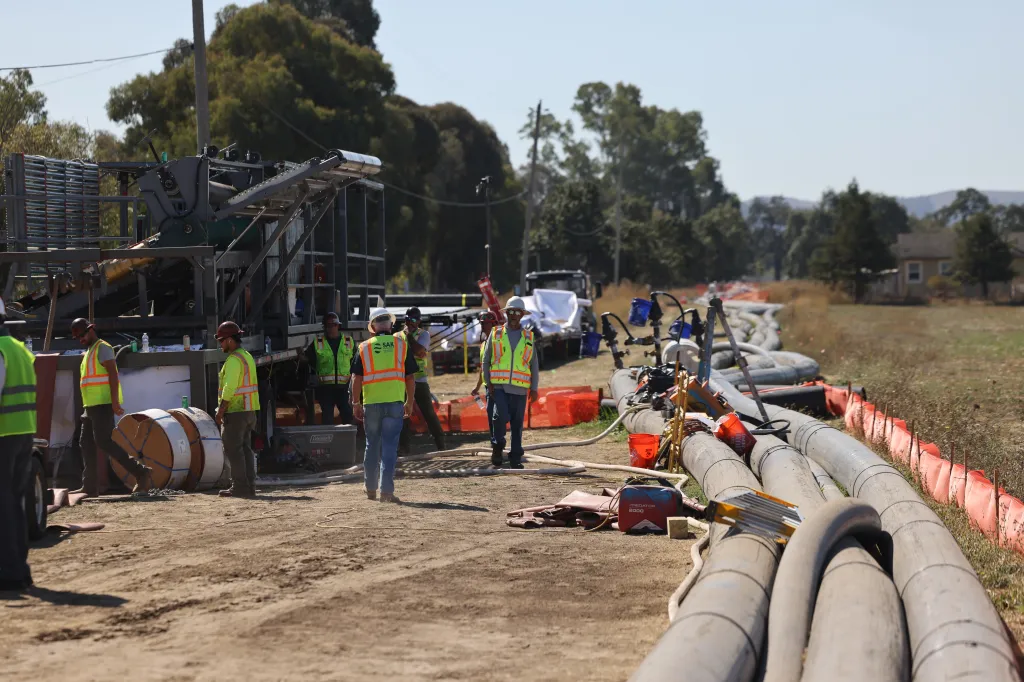
Construction workers on Tuesday prepared to flush hot water through two rust colored hoses dropped into a manhole just off Llano Road.
The water will help inflate a fabric liner inserted into a five-and-a-half-foot wide sewer trunk beneath the surface, sealing cracks and covering protruding rebar.
The sewer pipe, known as the Llano Trunk, is a major component of the regional water reuse system, delivering wastewater to Santa Rosa’s nearby Laguna Treatment Plant, where it’s both recycled for agricultural uses and to recharge geothermal fields at The Geysers bordering Sonoma and Lake counties.
But the plant’s 50-year-old pipe is deteriorating.
A city analysis showed sections of the concrete pipe were swelling and city officials found exposed reinforced metal in others, requiring critical repairs.
A failure along the trunk would be catastrophic, disrupting service to more than half the 230,000 residents served by the plant countywide and posing a hazard to sensitive habitat around the pipe, Santa Rosa Water officials told federal officials during site visit Tuesday.
The fabric liner being inserted into the sewer trunk is expected to extend the useful life of the pipe by another 50 years.
“This is one of the most important projects in the county,” Mayor Mark Stapp said during a tour highlighting infrastructure work at the wastewater facility.
The outing, which also included a visit to the construction site to highlight the work, was attended by Rep Jared Huffman, D-San Rafael, and Lt. Col. Virginia R. Brickner, commander and district engineer of the U.S. Army Corps of Engineers San Francisco District.
It comes as the city lobbies for additional aid for future phases of the rehabilitation project.
A 2021 risk analysis identified about nine miles of sewer trunk lines in need of repairs, at a cost of more than $78 million, though those costs are likely higher today.
Work got underway in June on the first phase of the Llano Trunk rehabilitation project on the southern terminus of the line.
The project calls for upgrading a 1.5-mile section of the pipe stretching from just north of Todd Road to the Laguna Plant.
Construction crews began by building a temporary, above-ground bypass to carry sewage typically conveyed through the Llano Trunk around the construction site. The trunk was then flushed out and inspected with cameras.
The city is using what’s known as cured-in-place pipe technology to reline the existing trunk.
The method calls for inserting an inverted fabric liner filled with resin into the trunk. Water reaching temperatures of up to 170 degrees is then circulated through it, expanding the liner and causing the resin to cure and form a new interior pipe, much like an angioplasty used to widen obstructed arteries.
The trenchless method limits ground disturbance and is more cost-effective and faster than digging out and replacing old sewer lines, said Richela Maeda, project manager and engineer with the water department.
On Tuesday, Huffman, outfitted with a neon yellow safety vest and white hard hat, climbed onto a metal structure built atop a manhole where the liner had recently been inserted and peered down to where the sewer pipe runs about 30 feet below.
Workers readied to unfurl hoses and fill the liner with hot water as the construction manager and Santa Rosa Water staff talked through the process with the tour group.
Once hardened, the liner is just a fraction of an inch thick and Maeda said it won’t have significant impacts on the trunk’s capacity. The smoother surface should allow wastewater to flow more easily through the pipe, she said.
At a cost of $14.7 million, the first phase is expected to be completed in mid-October.
Santa Rosa Water is responsible for about $5 billion in infrastructure, including about 1,200 miles of water and sewer lines and the regional Laguna Wastewater Treatment Plant, which treats and recycles wastewater for nearly half the county population.
Santa Rosa Water Director Jennifer Burke said the department must increase its investment in capital improvements to the system to address deterioration and futureproof it against natural disasters and climate impacts. That will help prevent costly emergency repairs in the future, she said.
Part of that work includes restoring the sewer trunks.
The next phase of the project will target a 1.2-mile section of the Llano Trunk extending north from where the current work is taking place.
Crews will rebuild the pipe and restore 12 manholes along the line.
Water officials intend to break up the work into several smaller steps to help manage costs. The first phase includes conducting environmental studies, design and permitting, at a cost of $3 million.
Liz Hanley, supervising engineer with Santa Rosa Water, said the city is looking to partner with the Army Corps on that phase. The city hopes the Corps can help conduct the environmental analysis and seek permits from several agencies, including the Regional Water Quality Control Board and California Department of Fish and Wildlife.
Santa Rosa also continues to seek state and federal dollars to help offset costs down the line.
Huffman, who secured a $2.3 million federal earmark for the project, said sanitation projects like the Llano Trunk replacement are critical to ensuring the region’s long-term water future and protecting the environment.
He committed to continue advocating for the project in Congress as the projects move forward.
“We obviously have to see it through,” he said. “This trunk line is just one part of a whole bunch of improvements necessary to make this really large wastewater system function so I’m going to try to help in any way I can.”
You can reach Staff Writer Paulina Pineda at 707-521-5268 or paulina.pineda@pressdemocrat.com. On X (Twitter) @paulinapineda22.



